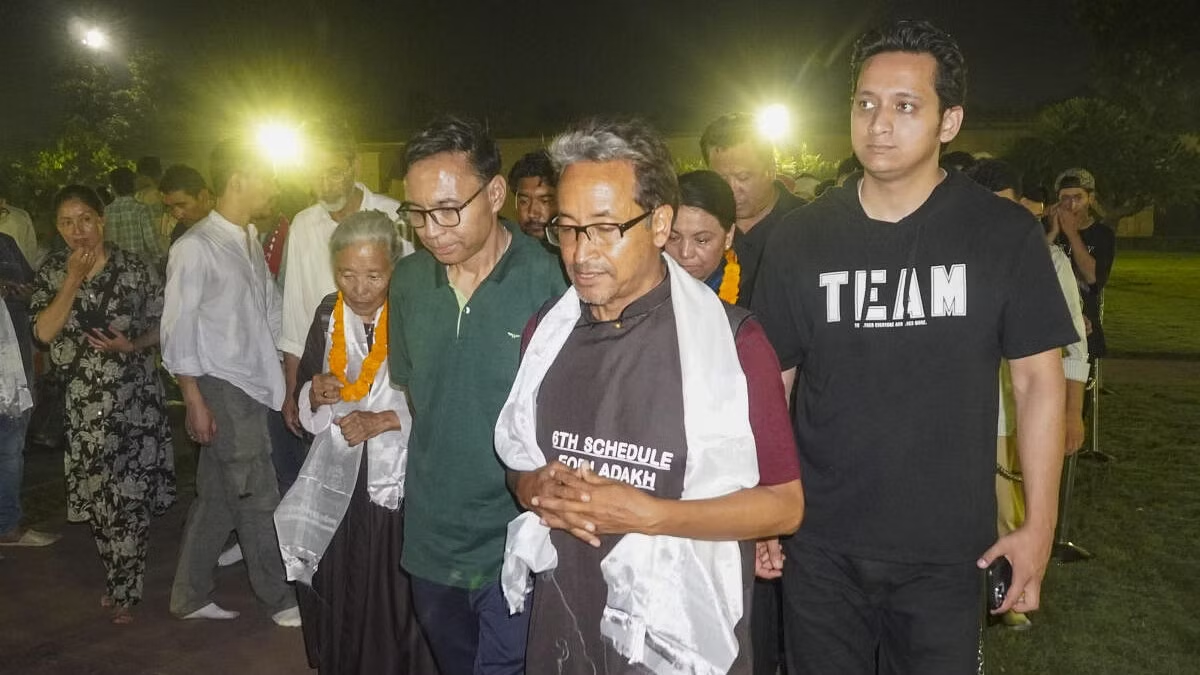Sonam Wangchuk’s Climate March in 2024 demanded constitutional safeguards for Ladakh under the Sixth Schedule, environmental protection, and statehood. Despite detentions, protestors highlighted the need to preserve Ladakh’s fragile ecosystem and advocated for sustainable development across the Himalayan region.

Climate activist Sonam Wangchuk, along with fellow Ladakhis, paid tribute to Mahatma Gandhi on his birth anniversary after being brought to Rajghat in New Delhi on Wednesday, October 2, 2024. Wangchuk and the group had been under police detention for several days. (Picture Source: PTI)
New Delhi, October 4, 2024 – On the evening of October 2, 2024, amidst heightened security in Delhi, the police released climate activist Sonam Wangchuk and members of the Climate March. The detainees were finally brought to Rajghat, where they paid their respects to Mahatma Gandhi, whose birth anniversary was being commemorated that day. The release followed a tense standoff and protests regarding the government’s stance on Ladakh’s demands for constitutional safeguards, which have far-reaching consequences for the entire Himalayan region.
The Demand for Constitutional Safeguards
At the heart of this protest is Ladakh’s demand for constitutional protection under the Sixth Schedule, which is designed to protect the rights of tribal communities in specific regions of India. As Wangchuk and the Climate March members emphasized, such safeguards are critical to preserving Ladakh’s fragile ecosystem and ensuring that local communities have a voice in their governance. During a press conference at Rajghat, Wangchuk revealed that a memorandum had been submitted to the Union government, highlighting Ladakh’s demands.
Wangchuk stated that the home ministry had assured them a meeting with India’s top leadership, including Prime Minister Narendra Modi, the President, and the Home Minister. On this promise, the protestors, who had been on an indefinite fast for nearly 48 hours, decided to break their fast. They had been detained by the Delhi police since September 30 at the Singhu border and taken to various police stations in Delhi, all while protesting for Ladakh’s constitutional rights and the broader environmental crisis facing the Himalayas.
Illegal Detentions and Protest March Disruptions
The detention of Wangchuk and the Climate Marchers sparked widespread outrage. Many activists, including Wangchuk, believed the detentions were illegal. As per Indian law, individuals can only be held in custody for up to 24 hours without being presented before a magistrate. By October 2, the detained marchers had exceeded this legal limit, as they remained in custody for over 40 hours without a formal hearing. Rajneesh Sharma, a lawyer and participant of the Climate March, voiced these concerns during a press conference organized by the People for Himalaya and Youth for Himalaya. Despite this violation of legal procedures, the marchers continued their peaceful protests while in custody.
Adding to the tension was the Delhi police’s imposition of a six-day prohibitory order on September 30, banning the assembly of more than five people in the city. This order effectively blocked the marchers’ plan to walk peacefully into Delhi on October 1 and culminate their march at Rajghat on October 2. The march, which spanned 1,000 kilometers from Leh to Delhi, was intended to draw attention to Ladakh’s environmental plight and its demands for statehood and constitutional protections. The prohibitory order and subsequent detentions were seen by many as an attempt to suppress this message.
The March’s Objectives: Ladakh’s Fight for Survival
Ladakh’s demands are clear and resonate across the entire Himalayan region. At the core of the movement is the call for the implementation of the Sixth Schedule in Ladakh, as promised by the ruling National Democratic Alliance (NDA) government. This would grant Ladakh autonomy and ensure that local communities play a larger role in governance, safeguarding both their rights and the environment.
Additionally, the protestors are pushing for Ladakh’s statehood, a commitment made during the bifurcation of Jammu and Kashmir in 2019, which has yet to be fulfilled. The demand for statehood is seen as crucial for amplifying Ladakh’s voice in national politics and ensuring that the region is no longer treated as a mere appendage of the Union Territory governance structure.
Another key demand concerns job reservations for Ladakhis, ensuring that government positions are made available to locals. The community also wants assurances that common lands used by locals, including grazing lands and glaciers that feed into vital water systems, will not be reclassified as government land. These lands are essential for the survival of Ladakh’s people, who rely on them for agriculture and grazing. Without these protections, the marchers argue, Ladakhis face the very real threat of becoming climate refugees in the near future.
Tsering Dolma, a Ladakhi activist, stated during the press conference that 97% of Ladakh’s population is tribal, underscoring the importance of these constitutional safeguards. She warned that without immediate action to protect Ladakh’s environment, its people would face irreversible environmental degradation and mass displacement.
Support from Other Himalayan States
The Climate March and its message have garnered widespread support from activists and environmentalists across the Himalayan region. Solidarity has been expressed by groups from Himachal Pradesh, Arunachal Pradesh, Uttarakhand, and Sikkim, all of which share similar environmental concerns. The Himalayas, home to some of the most fragile ecosystems in the world, are under increasing threat due to climate change and unchecked development. The Climate March serves as a clarion call for action to protect these ecosystems, which are vital not only to the survival of local communities but also to the health of the entire South Asian region.
Atul Sati, president of the Joshimath Bachao Sangharsh Samiti, noted that the issues raised by the Ladakhis transcend state and even national boundaries. He pointed to the recent floods in Nepal, which claimed over 200 lives, as a stark reminder of the interconnectedness of environmental crises in the region. Mayalmit Lepcha, general secretary of the Affected Citizens of Teesta in Sikkim, echoed these concerns, citing last year’s devastating cloudburst in Sikkim that destroyed the Teesta-III dam and claimed many lives. Local communities, Lepcha argued, are bearing the brunt of climate change, while political leaders continue to focus on short-term economic gains.
National and International Implications
The ongoing struggle in Ladakh reflects broader national and international debates about the balance between development and environmental protection. India’s rapid economic growth has come at the cost of its environment, with the Himalayan region being one of the most affected areas. The protestors argue that sustainable development must be prioritized to ensure the long-term survival of the country’s natural resources and ecosystems.
Medha Patkar and Prafulla Samantara, renowned social and environmental activists, were also detained by the Delhi police on October 2. The activists had gathered in silent protest at Gulab Vatika in solidarity with the Climate Marchers. Though they were released later that day, their detention highlights the growing resistance to environmental activism in India.
The Road Ahead: A Test for India’s Democracy
Sonam Wangchuk’s Climate March and the detentions have placed the Indian government in the spotlight. The decision to detain peaceful protestors, many of whom are elderly and have walked over 1,000 kilometers for their cause, raises serious questions about the government’s commitment to democratic values. Wangchuk’s reference to Gandhi’s philosophy of “living simply so that others may simply live” rings especially true in today’s context, where the race for development threatens the very fabric of India’s environment and communities.
While the Union government has assured the protestors that they will meet with top leadership, including Prime Minister Modi, the road to securing Ladakh’s demands remains uncertain. The movement’s future will depend not only on the government’s willingness to engage in dialogue but also on the sustained efforts of activists and environmentalists who understand that Ladakh’s fight is a fight for the future of the entire Himalayan region.
In conclusion, the Climate March led by Sonam Wangchuk represents a pivotal moment in India’s environmental and political landscape. It highlights the urgent need for constitutional safeguards in Ladakh, the protection of fragile ecosystems across the Himalayas, and a more sustainable approach to development. As the marchers continue their journey, the world watches to see whether India will rise to the challenge of balancing economic progress with environmental stewardship.

